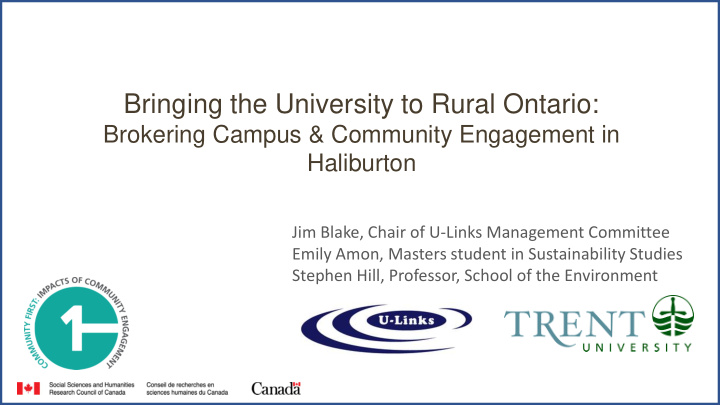



Bringing the University to Rural Ontario: Brokering Campus & Community Engagement in Haliburton Jim Blake, Chair of U-Links Management Committee Emily Amon, Masters student in Sustainability Studies Stephen Hill, Professor, School of the Environment
Where in the world Is Haliburton County? Haliburton County
Windy Pine She took great interest in the establishment of the Canadian Studies program at Trent University and in 1982 donated the property to be used as a retreat for faculty and students engaged in Canadian studies. Mary Northway, Professor of Psychology and Director of Research of the Institute for Child Studies at University of Toronto bought a property on Lake Kushog, Haliburton County and started a tripping camp for girls in 1941.
Inspired by “Our Common Future”, the Report of the UN’s Brundtland Commission in 1987, Professors John Wadland and Tom Whillans launched an interdisciplinary honours Bioregionalism Course at Trent University in the autumn of 1989 focused on the Haliburton Highlands with Windy Pine as its base.
U-Links Centre for Community-Based Research In partnership with the Township of Minden Hills and Trent University
U-Lin Links ks Cen entr tre e for or Com ommunity munity-Based ased Res esea earch rch
Active Transportation Plan Local Food Policy Poverty Reduction Strategy Examples of Impact on Recycling Policy Shoreline Evaluation Aging Well Master Plan Social Determinants of Health
Background
Sustainable Stormwater Management: Protecting Peterborough’s Harper Creek through Effective Policy & Priority placement of Rain Gardens (2017)
Community Based Research Creates a Buzz But does it Affect Change?
• Complex, Non-Linear Systems at Play • Impact is Contextual, and Attributed Differently by Different Stakeholders • Impacts can Relate to Project Process How Can We Assess (ie. Relationship Building) & Outcomes Impact? (ie. Report Recommendations) • Evaluations Theories Can Provide Defensible Methodology • Realist/Contribution Analysis (Mayne, 2008)
Current Research Interviews With Reconstruct Theory of Community Contribution Past Project Theory: Change Survey on Narrative Hosts and U- Contribution Workshop Impacts Analysis Links Admin Criteria
Preliminary Findings ● 26 Interviews ● ~100 Survey Respondents ● Outcomes: New Relationships , Recognition , Policy Change , Management Plans , Reflections/ Internal Evaluations, New Products , Baseline Data , Monitoring ● Factors: Project Sequencing / Strategic Planning , Competent Students , Communication, Scoping , Student-Host Relationships
How do universities benefit from their communities? In order to be good institutional citizens, universities should understand the transformative potential they hold within their communities. In exercising this in our teaching and research, we build capacity with students, and communities.
Community-based teaching & research as transformative for teaching, research and communities. This is a foundation for nurturing the legitimacy and relevance of universities.
• Directly involves communities, their needs and questions • Is a tool for community Community- development and community change Engaged Teaching & • Involves students, so they can Research… apply the skills they have learned in class (i.e., experiential) • Is deeply embedded in place and context (cf. Latour, 2005)
Community-university work can transform teaching & learning!
For example, a water festival
For example: Abbey Gardens in Haliburton
Potential models for community-based research Double credit undergrad honours Co-curricular projects thesis Graduate student Within a graduate internship/placement course (e.g., MITACS) Graduate student thesis (e.g., recent & new CFICE MASS students) Faculty research Single credit program & projects undergrad course ½ credit undergrad Course-based CBR course projects Service learning
Thank you. Jim Blake, Chair of U-Links Management Committee Emily Amon, Masters student in Sustainability Studies Stephen Hill, Professor, School of the Environment
Recommend
More recommend